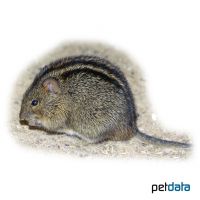Four-striped Grass Mouse (Rhabdomys pumilio)
| Four-striped Grass Mouse Rhabdomys pumilio | |
|---|---|
| Name | Four-striped Grass Mouse |
| Name Lat. | Rhabdomys pumilio |
| Family | Murids |
| Family lat. | Muridae |
| Order | Rodents |
| Order lat. | Rodentia |
| Origin | Africa |
| Climate | Subtropical - tropical |
| Habitat | Semi-desert, savanna |
| Diet | Seeds, plant matter, hay, insects |
| Behavior | Sociable, ♂ territorial |
| Keeping | Pair, group |
| Care Level | Easy |
| Life Span | 1-2 years |
| Protection | No |
| Metric Units | |
| Size | 10-12 cm |
| Temperature | 20-24 °C |
| Housing | A: 0.5 m² / H: 50-60 cm |
| US Units | |
| Size | 3.9"-4.7" |
| Temperature | 68-75 °F |
| Housing | 5 ft² / 20" hight |
Distribution and habitat
Diurnal striped grass mice are widespread from southern to eastern Africa, where they are found primarily in semi-deserts and mountain savannas up to over 2,000 m in elevation, but can also be found in grasslands and farmlands. They do not build underground burrows, but make their nests in dense bushes or use the burrows of other rodents.
Maintenance
Minimum dimensions for the enclosure:
| 1-2 animals | area: 0,5 m² | height: 50-60 cm |
| Each additional animal | Area: + 20 |
A terrarium placed in a bright (no direct sunlight), draught-free and quiet place is recommended, with ventilation openings on the sides, and it must not be tightly closed at the top. The enclosure should be structured with stones, roots and branches, and provide hiding and shelter opportunities (rodent houses, platforms, cork tubes, clay caves, hollowed coconuts, etc.). They need food and drinking containers (water bottles), nesting material (hay, grass) and a substrate for digging. Commercially available small animal litter or a peat and sand mixture covered with some bark mulch and dry leaves is suitable as a substrate. The bedding depth should be 10 cm. For the wear of their teeth must always be available nail material, such as untreated twigs and branches of fruit trees, and a rodent stone.
| temperature day: 20-24 °C | temperature night: 18-20 °C |
Light sources that also produce the necessary heat are ideal. A natural day-night rhythm must be ensured
Diet
They feed mainly on plants and insects. The species-specific diet consists of a low-fat grain mixture, available in specialist shops as "gerbil food", supplemented with forage hay, foxtail millet, fresh food (wild herbs, root vegetables, chicory) and a mineral stone. In addition, they need animal protein several times a week, such as live insects (crickets, house crickets, mealybug larvae) or insect food for hedgehogs. Fruit should be offered infrequently and in very small quantities. Drinking water must always be available and, like food, should be offered fresh daily
A varied diet promotes health and prevents deficiency symptoms.
Behaviour and compatibility
They are social animals and should be kept at least in pairs, but better in a group of 4-6 animals. A group should consist of one (castrated) male and several females (harem) or only females. There may be territorial fights between unneutered males. At the first sign of incompatibility, the animals must be separated immediately.
Reproduction and breeding
In the male, the anal and genital openings are farther apart than in the female.
The gestation period is about 21 days. A litter consists of 1-5 young, which are born blind and naked. They develop very quickly, are already independent after about 10 days and are already sexually mature at about 8-12 weeks. Both parents as well as the older siblings help in raising the young. The life expectancy is 1-2 years.
Important
They must not be fed permanently, because they easily become fat. It is recommended to feed small portions several times a day. In nature, they accumulate fat reserves in the rainy season (abundance of food) to survive the dry season (lack of food), which lasts several months
It is recommended to provide variety by changing furnishings and occasionally rearranging. As escape animals, they need sufficient retreat and hiding places, so the enclosure should also be somewhat elevated and not placed on the floor
They should not be grabbed or pulled by the tail, as the skin can easily tear and detach. Lighting and heat lamps should be placed in such a way as to prevent injury to the animals. Special attention must be paid to thorough hygiene and contamination must be removed regularly.
Further literature can be found in your pet store.
References
Text: petdata; Image: petdata
Source: W. PUSCHMANN, D. ZSCHEILE, K. ZSCHEILE (2009): Zootierhaltung - Tiere in menschlicher Obhut: Säugetiere, Harri Deutsch Verlag; EHRLICH (2006): Kleinsäuger im Terrarium, Natur und Tierverlag; BMEL (2014): Gutachten über Mindestanforderungen an die Haltung von Säugetieren
- Gemäß § 21 Abs. 5 Tierschutzgesetz idgF
